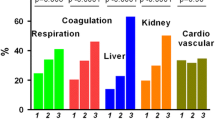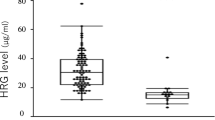Abstract
Purpose
To assess the prevalence and predictive value of natural autoantibodies to high-mobility group box 1 (HMGB1) during sepsis.
Methods
Anti-HMGB1 and anti-human serum albumin (HSA) autoantibodies were detected by ELISA in 178 plasma samples longitudinally collected from 40 critically ill patients with septic shock. One hundred thirty-two plasma samples from healthy donors were used as control.
Results
IgGs to HMGB1 were detected in 15/40 patients (37.5%). The prevalence of anti-HMGB1 antibodies was significantly higher in the patients who survived (55%) compared to the patients who did not (20%) (p < 0.0001). The detection of anti-HMGB1 antibodies during the course of the disease was significantly associated with patient survival (p = 0.038). Moreover, there is a progressive and significant emergence of anti-HMGB1 antibodies during the course of the disease, mostly in patients who survived.
Conclusions
This study shows that autoantibodies to HMGB1 are produced during sepsis and are associated with a favorable outcome in patients undergoing septic shock.



Similar content being viewed by others
References
Stros M (2010) HMGB proteins: interactions with DNA and chromatin. Biochim Biophys Acta 1799:101–113
Yang H, Tracey KJ (2009) Targeting HMGB1 in inflammation. Biochim Biophys Acta 1799:149–156
Bianchi ME (2009) HMGB1 loves company. J Leuk Biol 86:573–576
Scaffidi P, Misteli T, Bianchi ME (2002) Release of chromatin protein HMGB1 by necrotic cells triggers inflammation. Nature 418:191–195
Thorburn J, Horita H, Redzic J, Hansen K, Frankel AE, Thorburn A (2009) Autophagy regulates selective HMGB1 release in tumor cells that are destined to die. Cell Death Differ 16:175–183
Bell CW, Jiang W, Reich CF 3rd, Pisetsky DS (2006) The extracellular release of HMGB1 during apoptotic cell death. Am J Physiol Cell Physiol 291:C1318–C1325
Rauvala H, Rouhiainen A (2010) Physiological and pathophysiological outcomes of the interactions of HMGB1 with cell surface receptors. Biochim Biophys Acta 1799:164–170
Tsung A, Klune JR, Zhang X, Jeyabian G, Cao Z, Peng X, Stolz Geller DA, Rosengart MR, Billiar TR (2007) HMGB1 release induced by liver ischemia involves toll-like receptor 4 dependent reactive oxygen species production and calcium-mediated signaling. J Exp Med 204:2913–2923
Yu M, Wang H, Ding A, Golenbock DT, Latz E, Czura CJ, Fenton MJ, Tracey KJ, Yang H (2006) HMGB1 signals through toll-like recpetor (TLR) 4 and TLR2. Shock 26:174–179
Wang H, Bloom O, Zhang M, Vishnubhakat JM, Ombrellino M, Che J, Frazier A, Yang H, Ivanova S, Borovikova L, Manogue KR, Faist E, Abraham E, Andersson J, Andersson U, Molina PE, Abumrad NN, Sama A, Tracey KJ (1999) HMG-1 as a late mediator of endotoxin lethality in mice. Science 285:248–251
Ueno H, Matsuda T, Hashimoto S, Amaya F, Kitamura Y, Tanaka M, Kobayashi A, Maruyama I, Yamada S, Hasegawa N, Soejima J, Koh H, Ishizaka A (2004) Contributions of high mobility group box protein in experimental and clinical acute lung injury. Am J Respir Crit Care Med 170:1310–1316
Sunden-Cullberg J, Norrby-Teglund A, Rouhiainen A, Rauvala H, Herman G, Tracey KJ, Lee ML, Andersson J, Tokics L, Treutiger CJ (2005) Persistent elevation of high mobility group box-1 protein (HMGB1) in patients with severe sepsis and septic shock. Crit Care Med 33:564–573
Gibot S, Massin F, Cravoisy A, Barraud D, Nace L, Levy B, Bollaert PE (2007) High-mobility group box 1 protein plasma concentrations during septic shock. Intensive Care Med 33:1347–1353
Watanabe M, Uchida K, Nakagaki K, Kanazawa H, Trapnell BC, Hoshino Y, Kagamu H, Yoshizawa H, Keicho N, Goto H, Nakata K (2007) Anti-cytokine autoantibodies are ubiquitous in healthy individuals. FEBS Lett 581:2017–2021
Bakhiet M, Diab A, Mahamustafa Jiezhu, Lindqvist L, Link H (1997) Potential role of autoantibodies in the regulation of cytokine responses during bacterial infections. Infect Immun 65:3300–3303
Thierry S, Gozlan J, Jaulmes A, Boniface R, Nasreddine N, Strauss F, Marechal V (2007) High-mobility group box 1 protein induces HIV-1 expression from persistently infected cells. AIDS 21:283–292
Avrameas S, Guilbert B, Dighiero G (1981) Natural antibodies against tubulin, actin myoglobin, thyroglobulin, fetuin, albumin and transferrin are present in normal human sera, and monoclonal immunoglobulins from multiple myeloma and Waldenström’s macroglobulinemia may express similar antibody specificities. Ann Immunol (Paris) 132C:231–236
Angus DC, Yang L, Kong L, Kellum JA, Delude RL, Tracey KJ, Weissfeld L (2007) Circulating high-mobility group box 1 (HMGB1) concentrations are elevated in both uncomplicated pneumonia and pneumonia with severe sepsis. Crit Care Med 35:1061–1067
Karlsson S, Pettila V, Tenhunen J, Laru-Sompa R, Hynninen M, Ruokonen E (2008) HMGB1 as a predictor of organ dysfunction and outcome in patients with severe sepsis. Intensive Care Med 34:1046–1053
Fomsgaard A, Zhang GH, Shand GH, Bendtzen K, Baek L (1989) Immunochemical and biological reactivity of human anti-lipopolysaccharide IgG obtained by screening of blood donors. Scand J Immunol 29:309–316
Lacroix-Desmazes S, Bayry J, Kaveri SV, Hayon-Sonsino D, Thorenoor N, Charpentier J, Luyt CE, Mira JP, Nagaraja V, Kazatchkine MD, Dhainaut JF, Mallet VO (2005) High levels of catalytic antibodies correlate with favorable outcome in sepsis. Proc Natl Acad Sci USA 102:4109–4113
Urbonaviciute V, Furnrohr BG, Weber C, Haslbeck M, Wilhelm S, Herrmann M, Voll RE (2007) Factors masking HMGB1 in human serum and plasma. J Leuk Biol 81:67–74
Acknowlegdments
CB received a PhD fellowship from the Ministère de l’Enseignement Supérieur et de la Recherche français, from the Réseau Herpesvirus et Cancer and from La Ligue contre le Cancer. SBV is indebted to Mélanie Messmer for her helpful discussions and constant support. The authors are grateful to Dr. Joel Gozlan for comments and fruitful discussions.
Conflict of interest
All authors certify that there is no conflict of interest.
Author information
Authors and Affiliations
Corresponding author
Additional information
V. Maréchal and S. Gibot share the seniorship position.
Rights and permissions
About this article
Cite this article
Barnay-Verdier, S., Fattoum, L., Borde, C. et al. Emergence of autoantibodies to HMGB1 is associated with survival in patients with septic shock. Intensive Care Med 37, 957–962 (2011). https://doi.org/10.1007/s00134-011-2192-6
Received:
Accepted:
Published:
Issue Date:
DOI: https://doi.org/10.1007/s00134-011-2192-6




